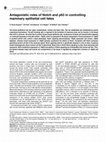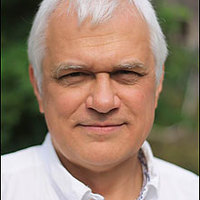Papers by Cathrin Brisken
Additional file 3: Figure S3. a Hematoxylin and eosin staining and immunohistochemistry for ERα o... more Additional file 3: Figure S3. a Hematoxylin and eosin staining and immunohistochemistry for ERα of MDA-MB-231 (ER-negative cell line) cells cultured in 2D (scale: 200 μm). b ERα gene (ESR1) expression in encapsulated microstructures cultured for 1 month relatively to MDA-MB-231 cells.
Additional file 6: Figure S6. Encapsulated tissue microstructures were cultured for 3–5 days in c... more Additional file 6: Figure S6. Encapsulated tissue microstructures were cultured for 3–5 days in complete medium, before challenge with fulvestrant for 2 weeks; ERα protein was detected by western blot; β-tubulin was used as loading control (N = 3, representative blot out of 2 technical replicates).
Additional file 3: Figure S3. a Hematoxylin and eosin staining and immunohistochemistry for ERα o... more Additional file 3: Figure S3. a Hematoxylin and eosin staining and immunohistochemistry for ERα of MDA-MB-231 (ER-negative cell line) cells cultured in 2D (scale: 200 μm). b ERα gene (ESR1) expression in encapsulated microstructures cultured for 1 month relatively to MDA-MB-231 cells.

The HMLE-Snail-ER and HMLE-Twist-ER cells were generated by infecting the HMLE cells with pWZL-Sn... more The HMLE-Snail-ER and HMLE-Twist-ER cells were generated by infecting the HMLE cells with pWZL-Snail-ER or pWZL-Twist-ER vectors followed by selection with 5 ng/ml of blasticidin. HMLE-Snail-Ras, HMLE-Twist-Ras, and HMLE-Vector-Ras cells were generated by infecting immortalized human mammary epithelial cells (Elenbaas et al., 2001) with retroviral vectors expressing Snail or Twist or the control vector and selecting with 2µg/ml puromycin. These cells were then transformed by introduction of a pWZL retroviral vector expressing the V12H-RAS oncogene followed by selection with 4µg/ml of blasticidin. Mammosphere culture Mammosphere culture was performed as described in Dontu et al 2003 (Dontu et al., 2003), except that the culture medium contained 1 % methyl cellulose to prevent cell aggregation. The mammospheres were cultured for 7-10 days. Then the mammospheres with diameter>75 µm were counted. For serial passages, mammosphere were harvested using 70 µm cell strainers after culturi...
Additional file 1: Figure S1. Sample weight.

Cell Death & Differentiation, Apr 9, 2010
The breast epithelium has two major compartments, luminal and basal cells, that are established a... more The breast epithelium has two major compartments, luminal and basal cells, that are established and maintained by poorly understood mechanisms. The p53 homolog, p63, is required for the formation of mammary buds, but its function in the breast after birth is unknown. We show that in primary human breast epithelial cells, maintenance of basal cell characteristics depends on continued expression of the p63 isoform, DNp63, which is expressed in the basal compartment. Forced expression of DNp63 in purified luminal cells confers a basal phenotype. Notch signaling downmodulates DNp63 expression and mimics DNp63 depletion, whereas forced expression of DNp63 partially counteracts the effects of Notch. Consistent with Notch activation specifying luminal cell fate in the mammary gland, Notch signaling activity is specifically detected in mice at sites of pubertal ductal morphogenesis where luminal cell fate is determined. Basal cells in which Notch signaling is active show decreased p63 expression. Both constitutive expression of DNp63 and ablation of Notch signaling are incompatible with luminal cell fate. Thus, the balance between basal and luminal cell compartments of the breast is regulated by antagonistic functions of DNp63 and Notch.
Breast Cancer Research, Nov 9, 2009
The phenotypic diversity of breast cancer has been proposed to result from different target cell ... more The phenotypic diversity of breast cancer has been proposed to result from different target cell types undergoing oncogenic transformation and giving rise to cancer stem cells. Global gene expression profiling revealed distinct molecular phenotypes and some of these signatures were held to reflect the cell of origin, with the basal carcinomas arising from basal/progenitor cells. Recent work challenges this view by providing evidence that luminal precursor cells are involved in the pathogenesis of basal breast cancers and has made new links between normal cell populations and molecular tumor phenotypes.
Breast Cancer Research, Jan 28, 2011

Development, 2020
17β-Estradiol induces the postnatal development of mammary gland and influences breast carcinogen... more 17β-Estradiol induces the postnatal development of mammary gland and influences breast carcinogenesis by binding to the estrogen receptor ERα. ERα acts as a transcription factor but also elicits rapid signaling through a fraction of ERα expressed at the membrane. Here, we have used the C451A-ERα mouse model mutated for the palmitoylation site to understand how ERα membrane signaling affects mammary gland development. Although the overall structure of physiological mammary gland development is slightly affected, both epithelial fragments and basal cells isolated from C451A-ERα mammary glands failed to grow when engrafted into cleared wild-type fat pads, even in pregnant hosts. Similarly, basal cells purified from hormone-stimulated ovariectomized C451A-ERα mice did not produce normal outgrowths. Ex vivo, C451A-ERα basal cells displayed reduced matrix degradation capacities, suggesting altered migration properties. More importantly, C451A-ERα basal cells recovered in vivo repopulating ability when co-transplanted with wild-type luminal cells and specifically with ERα-positive luminal cells. Transcriptional profiling identified crucial paracrine luminal-to-basal signals. Altogether, our findings uncover an important role for membrane ERα expression in promoting intercellular communications that are essential for mammary gland development.
Molecular and Cellular Biology, Jun 15, 2010
FEBS Journal, 2011
Reference EPFL-CONF-171224View record in Web of Science Record created on 2011-12-16, modified on... more Reference EPFL-CONF-171224View record in Web of Science Record created on 2011-12-16, modified on 2017-05-12
Nature Cell Biology, Sep 30, 2015
In the original version of this Article, a sentence was changed in error during production. This ... more In the original version of this Article, a sentence was changed in error during production. This sentence should have read 'To understand to what extent mTOR regulates the SASP, we analysed the secretome of senescent cells by mass spectrometry (MS; refs 24, 25). ' There was a further typographical error in one instance of 'SASP components'. These errors have been corrected in all online versions of the Article.

Wiley Interdisciplinary Reviews-Developmental Biology, Jan 23, 2015
Most of mammary gland development occurs postnatally under the control of female reproductive hor... more Most of mammary gland development occurs postnatally under the control of female reproductive hormones, which in turn interact with other endocrine factors. While hormones impinge on many tissues and trigger very complex biological responses, tissue recombination experiments with hormone receptor‐deficient mammary epithelia revealed eminent roles for estrogens, progesterone, and prolactin receptor (PrlR) signaling that are intrinsic to the mammary epithelium. A subset of the luminal mammary epithelial cells expresses the estrogen receptor α (ERα), the progesterone receptor (PR), and the PrlR and act as sensor cells. These cells convert the detected systemic signals into local signals that are developmental stage‐dependent and may be direct, juxtacrine, or paracrine. This setup ensures that the original input is amplified and that the biological responses of multiple cell types can be coordinated. Some key mediators of hormone action have been identified such as Wnt, EGFR, IGFR, and RANK signaling. Multiple signaling pathways such as FGF, Hedgehog, and Notch signaling participate in driving different aspects of mammary gland development locally but how they link to the hormonal control remains to be elucidated. An increasing number of endocrine factors are appearing to have a role in mammary gland development, the adipose tissue is increasingly recognized to play a role in endocrine regulation, and a complex role of the immune system with multiple different cell types is being revealed. WIREs Dev Biol 2015, 4:181–195. doi: 10.1002/wdev.172This article is categorized under: Gene Expression and Transcriptional Hierarchies > Cellular Differentiation Signaling Pathways > Global Signaling Mechanisms Signaling Pathways > Cell Fate Signaling
Journal of Mammary Gland Biology and Neoplasia, Nov 17, 2006
The mouse mammary gland is a complex tissue that proliferates and differentiates under the contro... more The mouse mammary gland is a complex tissue that proliferates and differentiates under the control of systemic hormones during puberty, pregnancy and lactation. Once a highly branched milk duct system has been established, during mid/late pregnancy, alveoli, little saccular outpouchings, sprout all over the ductal system and differentiate to become the sites of milk secretion. Here, we review the emerging network of the signaling pathways that connects hormonal stimuli with locally produced signaling molecules and the components of intracellular pathways that regulate alveologenesis and lactation. The powerful tools of mouse genetics have been instrumental in uncovering many of the signaling components involved in controlling alveolar and lactogenic differentiation.
Journal of Investigative Dermatology, 2006

Little is known about the biological functions which are exerted by hormone receptors in physiolo... more Little is known about the biological functions which are exerted by hormone receptors in physiological conditions. Here, we made use of the Mouse INtraDuctal (MIND) model, an innovative patient-derived xenograft (PDX) model, to characterize global gene expression changes, which are triggered by stimulation of dihydrotestosterone (DHT) and progesterone (P4) in vivo. Fast and clever mathematical tools are needed to analyze increasing numbers of complex datasets. We generated hormone receptor-specific list of genes which were then used to test the classification performance obtained by different machinelearning algorithms in the frame of our labelled PDXs RNAseq dataset. Next to other standard techniques, we consider the variably scaled kernel (VSK) setting in the framework of support vector machines. Our results show that mixed schemes obtained via VSKs can outperform standard classification methods in the considered task. Index Terms-Variably scaled kernels, patient-derived xenografts, hormones
Development, Dec 1, 2011
The ID family of helix-loop-helix proteins regulates cell proliferation and differentiation in ma... more The ID family of helix-loop-helix proteins regulates cell proliferation and differentiation in many different developmental pathways, but the functions of ID4 in mammary development are unknown. We report that mouse Id4 is expressed in cap cells, basal cells and in a subset of luminal epithelial cells, and that its targeted deletion impairs ductal expansion and branching morphogenesis as well as cell proliferation induced by estrogen and/or progesterone. We discover that p38MAPK is activated in Id4-null mammary cells. p38MAPK is also activated following siRNA-mediated Id4 knockdown in transformed mammary cells. This p38MAPK activation is required for the reduced proliferation and increased apoptosis in Id4-ablated mammary glands. Therefore, ID4 promotes mammary gland development by suppressing p38MAPK activity.
Cancer Cell, Sep 1, 2020
Highlights d IL6/STAT3 signaling drives metastasis in ER + breast cancer mouse models d IL6/STAT3... more Highlights d IL6/STAT3 signaling drives metastasis in ER + breast cancer mouse models d IL6/STAT3 establishes shared ER-FOXA1-STAT3 enhancers independent of FOXA1 d STAT3 co-opts shared enhancers to drive a distinct gene program independent of ER d JAK inhibitor ruxolitinib represses IL6/STAT3 activity and in vivo invasion Authors










Uploads
Papers by Cathrin Brisken